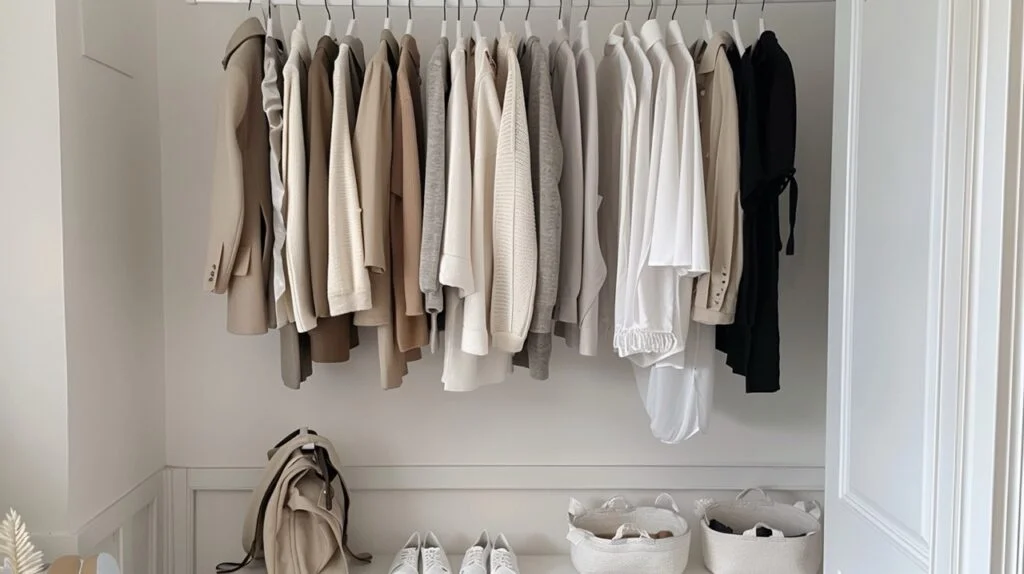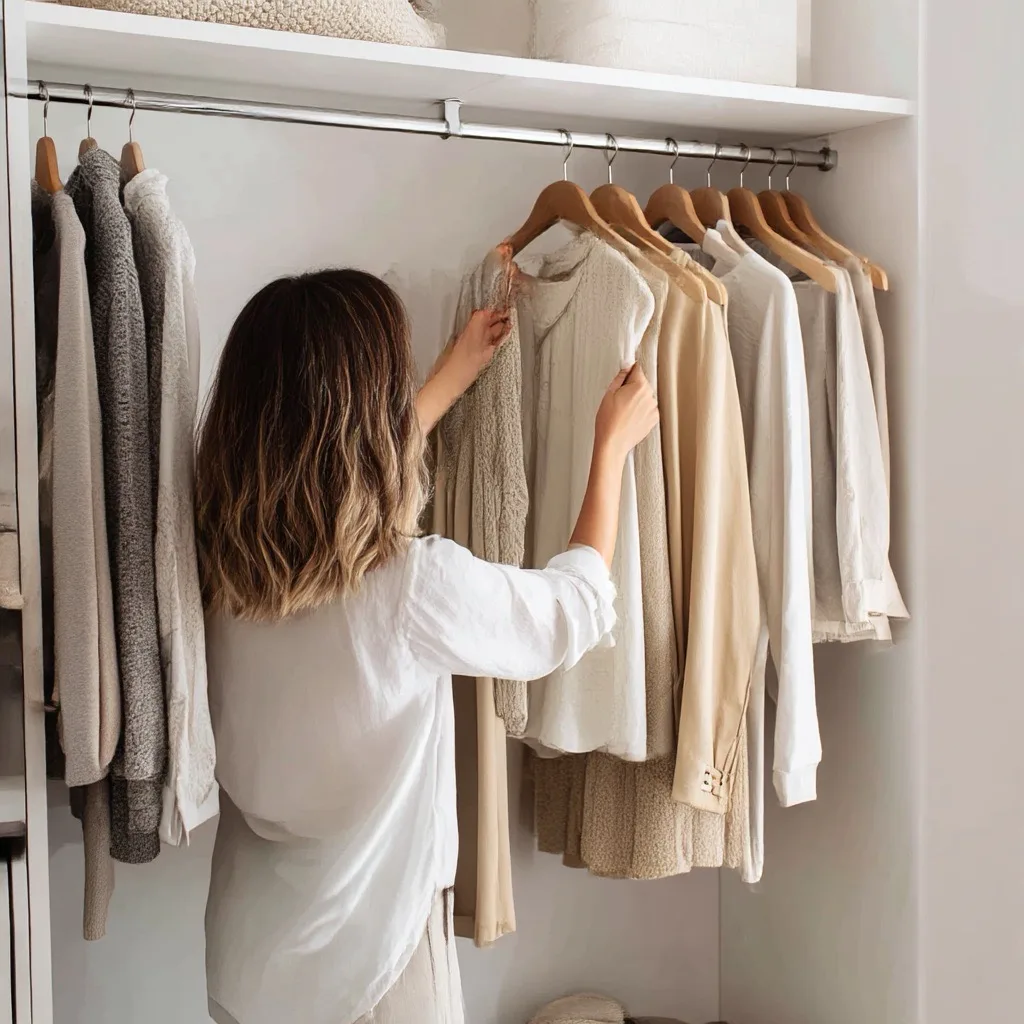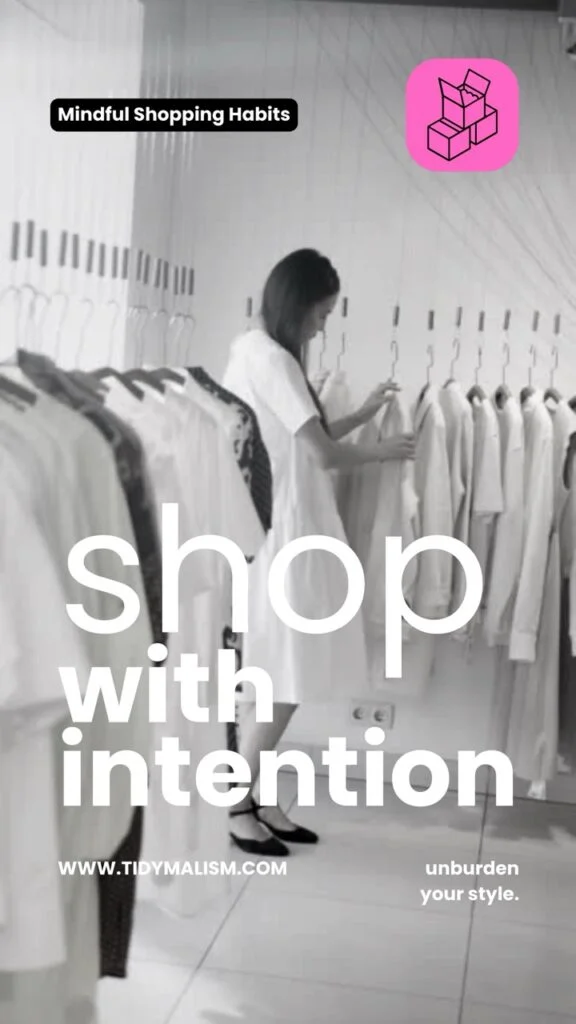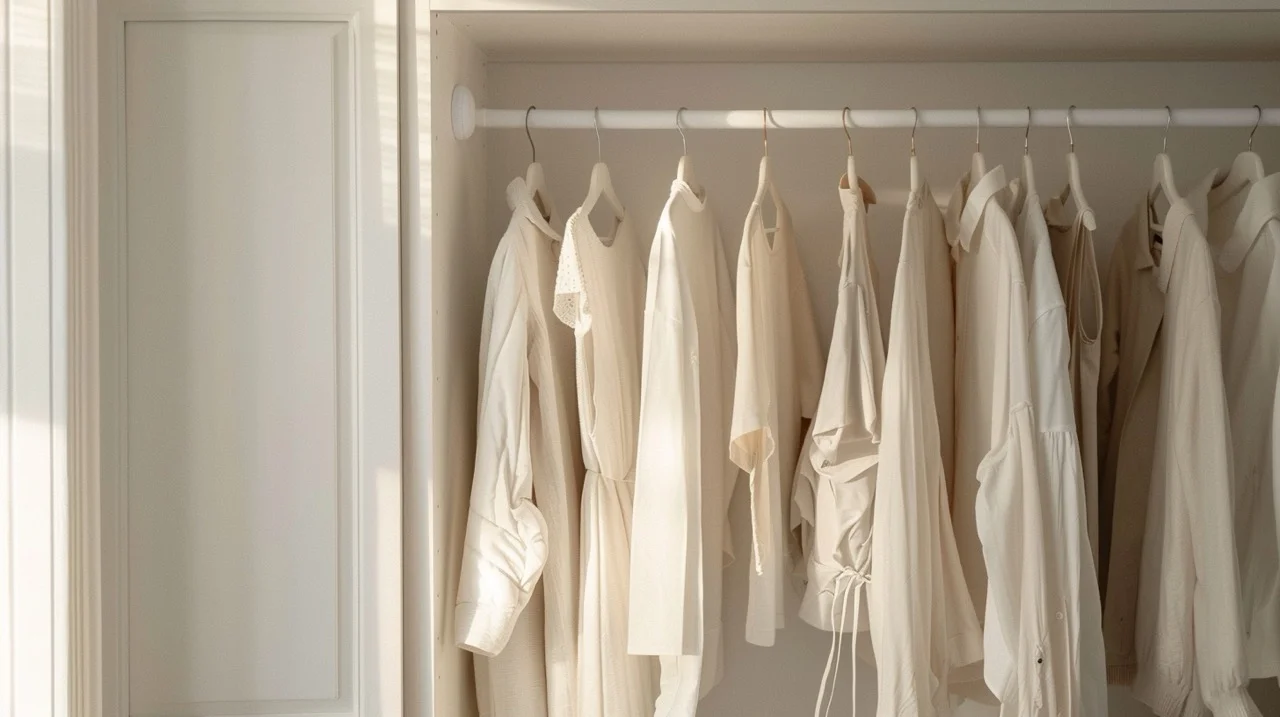Fast fashion has really done a job us. I’m not just talking about how it’s destroying the environment more than the aviation and shipping industries combined, either. It’s also wreaked havoc on our closets and wallets.
Table of Contents
The Situation
Permanent sales and online shopping for entertainment have led many of us to develop rather impulsive buying habits. It’s too easy browsing online, there are $5 t-shirts galore at the mall, and a newsletter with a discount code is to be had pretty much everywhere you turn on the web.
And don’t even get me started about influencers or TikTok shopping. The result, for many of us at least, is that our closets are stuffed. Oftentimes with things we don’t even wear!
Adopting a mindful minimalist shopping approach is a good way out of this kerfuffle. I know getting more intentional about what I purchase has helped me curate my own wardrobe, and it has definitely paired well with slow closet decluttering. I still read Vogue and follow Brendahashtag & co., but I’m definitely more immune to the constant churn of trends these days.
I’ve written more extensively about what intentional spending means in past posts. I’d describe it as a mix of conscious decision-making, focusing on quality over quantity, and aligning what you buy with your personal values and style identity.
In short, really thinking twice before you whip out your credit card, and being critical of how well something is made before you buy it.
Personally, I’m not a huge fan of dogmatic “rules” but the five guidelines outlined below helped me navigate my shopping habits more mindfully, and I think they can help you get more joy and utility out of your future clothing purchase, too.
Define Your Style Identity
Why Knowing Your Style Matters
Having a good sense of your personal style is a cornerstone of shopping with intention. When you know what suits you and what you feel good in, it’s all the easier to resist the allure of fleeting trends that may not align with your preferences in real life.
One question I ask myself nowadays before making a purchase is if the garment is really for me and my life right now, or if it’s for a fantasy version of some future self that doesn’t exist.
If you want to shop with a more minimalist mindset, it’s a great question to ask yourself when shopping.
Once you’ve honed in on your personal style identity, it’s both easier to shed some stuff from your closet and curate a wardrobe you actually enjoy wearing and get use out of.
Finding Your Core Essentials
So how do you find your style identity? There are a few exercises you can try:
- Audit your current wardrobe. Take stock of what you already have the next time you declutter your closet. Make a note of the pieces you frequently wear and why you like them. Identify common themes such as colours, cuts, or silhouettes that resonate with you.
- Look for patterns. Not on your actual clothes, but in the things you frequently reach for when getting dressed. What are your favourite go-to outfits? Do you tend to gravitate towards a specific colour palette or silhouette when you go shopping? These preferences are a good indicator of your personal style.
- Identify your comfort zones. Are there certain fabrics and fits that make you feel more comfortable and confident than others? These are the things you should also make a mental note of when you’re shopping for a new garment. If you know you feel better in 100% cotton than polyester mixes, that’s a pretty good reason to leave that synthetic dress that’s 60% off on the rack. You just will never feel as good in it as you do in a cotton dress.

Visualising your style can be helpful throughout this whole process. Pinterest is great for curating a mood board of inspiring images.
Another good trick is to use your smartphone to take a picture of your outfit every day. Add a note to the picture at the end of the day about how you felt in it. After 14 days, review your pictures and notes. I bet you’ll see a pattern emerge, and I bet you’ll even discover at least one item you’ll want to declutter from your closet.
Shop Like a Minimalist
Invest in Timeless Pieces
Mindful minimalist shopping generally emphasises investing in timeless pieces that withstand fashion’s ephemeral nature. You know the old adage: quality over quantity.
The upfront cost of some things may scare you away at first glance, but minimalist shopping strategies like this actually save you money in the mid to long term, because you’ll get a much cheaper cost per wear.
Some things to look out for when picking timeless pieces:
- Longevity and versatility: Go for items that transcend seasonal trends and can be worn year after year. Classic wardrobe staples I reach for again and again include gold hoops, a tailored navy blazer, white shirts, black trousers, and denim jeans that fit really well.
- Craftsmanship and durability: Be critical of the sewing quality of a garment, its materials, and finishes when evaluating potential purchases. Paying attention to details such as stitching, fabric weight, and hardware helps you identify well-made garments that will better stand the test of time. You might also want to avoid anything that’s labelled “dry cleaning only” if you want to save money.
Consider Cost Per Wear
Cost per wear is a simple equation that allows you to evaluate the value of an item based on how often you’ll wear it:
Cost per Wear = Total Cost of Item / Estimated Number of Times You’ll Wear It
A well-made coat from Max Mara may have a high price tag but it will never go out of style and you’ll have it for many, many years. This results in a lower cost per wear compared to a cheaper coat that won’t last as long or won’t be worn as often.
Or vice-versa: that $5 t-shirt from the sale at Zara? It’s likely to be ready for the bin after just one wash. Ergo: donning it once cost you five bucks. A $50 t-shirt, on the other hand, can hold up for a few years, coming in at a few cents per wear. Bonus: the longer you get wear out of something, the more environmentally friendlier it is, too.

A Side Note on Ethical Minimalism
I’ve written before on creating a conscious closet, and the benefits of natural and sustainable materials deserve another mention here for a few good reasons:
- Environmental impact. Natural fibres like cotton, linen, hemp, or silk are biodegradable and have a lower carbon footprint compared to synthetic fabrics like polyester and nylon.
- Comfort and breathability. Natural fibres can breathe better and they’re naturally hypoallergenic, making them ideal for those with sensitivities or in hot climates.
- Durability. Natural fibres hold up better, contributing to the longevity of garments.
When shopping, you can keep your eyes peeled for certification labels from the likes of Global Organic Textile Standard (GOTS) or Fair Trade to ensure that the materials used in the production of your garments are ethically sourced and processed.
Clear the Clutter and Make a List
Declutter and Assess Your Closet
Time is relative and while some organising gurus might advise you to declutter your closet multiple times a year, that frequency may not be your cup of tea. Personally, I like to go through my closet about once a year. Other folks might only do a big declutter sesh when they feel they’re running out of room, or when they know they want to buy a lot of new clothes in one go.
No matter how you do it though, a proper wardrobe audit really helps tidy up your closet space and it can provide clarity on any gaps you may have in your wardrobe. It also helps in the ongoing refinement of your personal style.
There are quite a few ‘closet’ posts here on Tidymalism. If you’d like to get into the nitty-gritty, just use the search bar above! For brevity, what I like to do when I’m working through a section of my Ikea Pax closet is:
- Categorise existing items into three main groups: keep, donate/sell, and repair. Anything I love, wear frequently, and feel good in is an obvious keeper. Anything still new or of high value gets resold. Items of low value that are in good condition go to the Red Cross. And anything in need of dry cleaning or repairing goes into a bag that I can drop off next time I head out to run errands.
- Evaluate by utility, i.e. I’ll consider how often I wear the pieces of clothing I have and whether or not I actually like wearing them. I think it’s worthwhile being honest with yourself here. I know it’s super hard letting go of things that were expensive, but if you’re not getting any use or wear out of them, they’re occupying both your space and your mind. It might be time to let them go. The good news is that you can actually recoup a lot of what you spent. (Check out my post on making money with clutter to get started with re-selling!)
Create a Shopping List Before Spending Money
When I’m decluttering per the above, I’ll make a note of anything I seem to be missing in my closet.
Maybe I decluttered three scuzzy white tees that need to replaced, for example. I’ll jot down a white tee. I keep this list on my phone which syncs with my laptop, so it’s always handy whether I’m in a physical shop or shopping online. It helps resist the temptation of impulse buying and just keeps me focused on acquiring the items that I actually need, rather than simply adding more clutter.
When it’s time to make purchases, I then aim for versatility and quality in whatever I add to my shopping cart.
Set a Budget and Stick to It
If you’re like me and were not born into a trust fund, shopping intentionally will likely also involve setting a budget and at least trying to stick with it.
You can set a fixed amount you have to work with for the month or year, or you can do what I do and say that you’re only allowing yourself to make X number of purchases. (For me it’s a maximum of five new things per season.)
Whichever type of rule you make for yourself, you’ll find that setting a budget not only helps you maintain better financial mindfulness but also encourages intentional decision-making when it comes to purchasing new items for your wardrobe. And that, dear reader, will keep your closet relatively clutter-free over time.
Other Ways to Shop with Intention
Discover Unique, Pre-Loved Finds
Second-hand and vintage shopping offers numerous advantages beyond the thrill of uncovering totally unique pieces you’re guaranteed not to see at the mall. Plus, there’s something out there for every budget, whether low or high.
In of itself, minimalism isn’t just about reducing the amount of stuff you have; it’s also about conscious consumerism. Thrifting fits in perfectly here because of its environmental benefits. Choosing pre-loved clothing reduces the demand for new production and mitigates the environmental impact associated with fast fashion.
When it comes to shopping second-hand options, work with the same guidelines as above. Refer to your list of things you need or want to replace, be critical of quality and fit, and never buy anything you don’t feel good in.
Support Ethical Brands and Slow Fashion
Supporting ethical and sustainable brands is another powerful way to align your personal values with your mindful shopping practices.
Look for brands that prioritise fair trade, minimise environmental impact, and have transparent supply chains. Every time you buy new things, you’re essentially voting with your wallet, so you can just as well cast a vote to say NO to brands whose morals seem misaligned with your own.
The slow fashion movement ties in here great, too. It’s basically the antithesis of fast fashion’s culture of instant gratification. By embracing slow fashion, you’re actively rejecting purchasing garments on a whim and instead adopt strategies for more deliberate shopping.
Simplify Your Shopping Cart… with Gratitude

Appreciate What You Already Own
It may sound corny, but there’s a lot of value in what you already have, and cultivating a mindset of gratitude for your current wardrobe can help you realise you might not need to buy something new at all to feel satisfied.
I do a couple of simple things to reduce my own urge to constantly acquire more, and it helps me appreciate what’s already hanging in my closet:
- Wardrobe rotation. Regularly rotating items in your closet can help you rediscover forgotten favorites and give neglected pieces a chance to shine. A lot of folks like to use the backward hanger trick as well: every time you’ve worn something, reverse-hang it back into the closet. You’ll see at a glance what you’re not using and can focus on those garments when getting dressed. And if you wind up not wearing them at all, you’ve already got a super head start on your next decluttering session.
- Mixing and matching. I like to play around with different combinations to create new outfits using my existing pieces. It often surprises me how versatile some things really can be.
However you practise gratitude, shifting your focus away from constant consumption and seeing new potential and value in the clothes you already have definitely makes it easier to identify what you don’t need.
Add Value to Your Life with Mindful Minimalist Shopping
In conclusion, mindful minimalism goes a bit deeper than decluttering your closet or saving money—though those are definitely perks. I’d say that intentional shopping adds genuine value to our lives. And that it helps simplify your life in the long term. By defining your style identity, investing in quality pieces, shopping ethically, and appreciating what you already own, you’re not just curating a wardrobe—you’re honing a lifestyle.
Nobody’s perfect, it’s a process. You might still occasionally fall for that irresistible sale item on a whim (we’re all human, after all). But armed with some new mindful shopping strategies, I’d wager you’ll find yourself making more conscious decisions that align with your values and your authentic self.
As you navigate this path, you’re also bound to discover that a thoughtfully curated wardrobe can bring a sense of calm and confidence to your daily life. You’ll spend less time fretting over what to wear and more time enjoying the clothes you love. And isn’t that what style is really all about?
So, the next time you’re tempted by a flash sale or an influencer’s must-have list, take a breath. Consider your style identity, check your shopping list, and ask yourself if this purchase is really what you want or need.
Now, I’d love to hear from you. Have you tried any of these mindful shopping strategies? How have they impacted your relationship with your wardrobe and shopping habits? Drop a comment below!














Leave a Reply